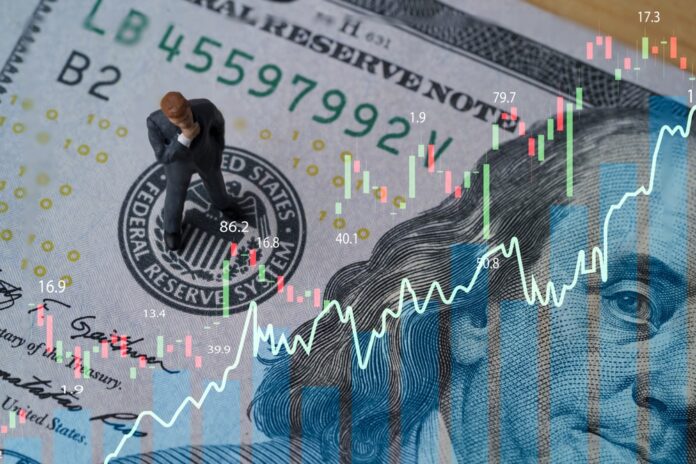The US dollar rose on Monday, reaching a three-week high after US President Donald Trump made good on his threat of more trade tariffs, boosting demand for the safe haven.
The dollar index, which tracks the behavior of the US dollar against a basket of six other currencies, was trading nearly 1% higher at 109.305 after reaching a three-week high.
Dollar soars on announcement of tariffs
Over the weekend, President Trump announced, as promised last month, 25% import tariffs on both Canada and Mexico, and a 10% tariff on China, describing the measures as necessary to combat illegal immigration and drug trafficking.
All three countries promised to retaliate, possibly signaling the start of a new global trade war, which has given way to a renewed demand for the US dollar as a safe haven.
The Chinese yuan fell to an all-time low against the dollar in the offshore market, with China’s markets still closed for the Lunar New Year, while the Mexican peso fell to its lowest level in nearly three years and the Canadian dollar plummeted to a level not seen since 2003.
“It seems that the ‘maximum pressure’ negotiating position of this new Trump administration is to impose tariffs first, perhaps in an effort to get the best deal as quickly as possible,” ING analysts said in a note. ”The problem for investors, however, is that the outcome of these tariffs remains unclear.”
“The reaction in the currency market has been, unsurprisingly, a defensive rebound in the dollar. The DXY index rose one percent. The currencies most affected were, understandably, commodity currencies, those that benefit from global growth,” ING added.
Apart from the possible impact on global growth, tariffs could be inflationary as far as the US economy is concerned, and investors have slightly reduced their estimates of rate cuts by the Federal Reserve this year.
The Federal Reserve left its benchmark overnight interest rate in the range of 4.25%-4.50% the previous week, and officials removed the reference that inflation had “progressed” toward the Fed’s 2% inflation target.
The euro is hit hard by tariff fears
In Europe, the EUR/USD pair fell 1.1% to 1.0248, with the single currency falling to its lowest level since November 2022, as investors prepared for tariffs on Europe by the Trump administration.
In an interview with the BBC, Trump said that similar tariffs with the European Union “will definitely happen”, describing the trade deficit with the EU as “an atrocity”.
The United States had a trade deficit with the European Union of nearly $200 billion last year.
“The growing prospect of a global trade war and tariffs targeting the EU is clearly negative for the euro,” ING added.
Slightly helping the euro, data released on Monday revealed that the decline of the German manufacturing sector eased in January.
Germany’s manufacturing purchasing managers’ index (PMI), compiled by S&P Global, rose to 45.0 in January from 42.5 in December, marking the highest reading since May of the previous year.
The final reading is almost one point higher than the preliminary figure of 44.1, although it remains firmly below the 50-point mark that separates growth from contraction.
The European Central Bank cut interest rates by a quarter of a percentage point the previous week, the fifth reduction of this kind since June, ahead of estimates that the biggest increase in inflation for generations is almost over and the battered economy requires relief.
All eyes are now on the release of the eurozone’s flash CPI later in the session, which is expected to come in at 2.4% y/y in January, slightly above the ECB’s medium-term target of 2.0%.
The GBP/USD pair fell 0.1% to 1.2313, with the pound sterling relatively little affected after Trump did not stop imposing tariffs on UK products in the interview he gave to the BBC, although he added that the situation “can be resolved”.
“The pound sterling has been one of the least affected G10 currencies, possibly because the UK has a trade deficit with the US and exports of goods to GDP are relatively small,” ING said.
The Bank of England will hold a monetary policy meeting later this week, at which the central bank could cut interest rates in an attempt to stimulate the moribund economy.
Offshore yuan near all-time low
In Asia, the USD/CNH pair rose 0.3% to 7.3400, with the offshore yuan touching record lows after the announcement of a 10% import tariff by the US, a decision that bodes ill for the Chinese economy, which relies heavily on exports.
Beijing condemned Trump’s tariffs and threatened retaliation. The country is also expected to distribute extraordinary stimulus measures to offset the economic impact of Trump’s tariffs.
Private sector purchasing manager index data indicated that Chinese business activity remained weak in January. The Caixin manufacturing PMI was below forecasts for the month, although it managed to remain in expansion territory.
The USD/JPY pair rose 0.1% to 155.22, with the Japanese yen weakening to a lesser extent than its counterparts due to the Bank of Japan’s hardline stance and its status as a safe haven asset.



